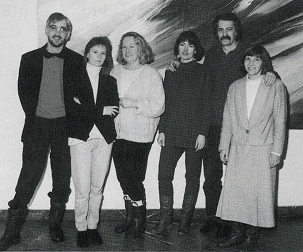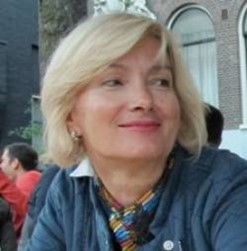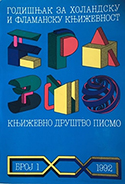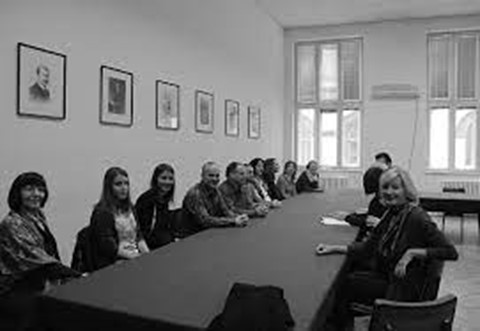Translators as cultural mediators
Translators are regarded as one of the most important cultural mediators of foreign language literature. From book selection and reviews to the promotion and marketing, the role of a translator extends far beyond the mere act of translation. This was especially true in the case of cultural and literary exchange between the so-called small or peripheral languages like Serbian and Dutch.
Book lovers in Serbia can enjoy some of the most beautiful novels and poetry written by well-known classic and contemporary writers from the Netherlands and Flanders, including Hugo Claus, Willem Elsschot, Harry Mulisch, Cees Nooteboom, Herman Koch and Dimitri Verhulst thanks to the enthusiasm and commitment of the three translators: Ivana Šćepanović, Jelica Novaković-Lopušina and Olivera Petrović van der Leeuw.
The upsurge of literary translation from Dutch

Ivana Šćepanović and Jelica Novaković-Lopušina (third and fourth from the left); Olivera Petrović van der Leeuw (first on the right)
Before the 1990s, translations of Dutch and Flemish literature were sporadic and mostly relay translations made via German, French, or English. However, the period between 1990 and 2000 was marked by an upsurge of literary translation from Dutch into Serbian. Jelica Novaković-Lopušina, a German lecturer at the Department of German Studies in Belgrade at the time, played a crucial part in this shift. Following her love for the Dutch language – which she learned as a child while living in The Hague – she founded a lectureship in Dutch at the Faculty of Philology in Belgrade in 1987. As a lecturer, she introduced her students not only to the Dutch language but to literature and culture as well. Among her first students were Ivana Šćepanović and Olivera Petrović van der Leeuw.
Since 1990, the trio has translated over 100 titles, introduced more than 50 Dutch and Flemish authors to the Serbian readership, started a literary magazine dedicated to Dutch and Flemish literature, as well as the book series Dutch Literature in Translation at the publishing company Prometej, from Novi Sad. Moreover, they organized and participated in translation workshops and numerous literary events aimed at promoting Dutch and Flemish literature in Serbia.
The people behind the translation
Ivana Šćepanović studied English and Italian language and literature. For many years, she worked as a proof-reader and editor at the renowned ex-Yugoslav publisher, Narodna knjiga in Belgrade. She translated approximately 100 books (both non-fiction and fiction) from English, Italian, Russian and Spanish into Serbian before she started learning Dutch at the Faculty of Philology. After attending a summer school in the Dutch language in Belgium, she discovered Flemish literature and one of its most prominent writers, Hugo Claus. This passion led her to translate an astonishing 10 works by this author.

Jelica Novaković-Lopušina
Jelica Novaković-Lopušina attended both elementary school and high school in the Netherlands, where she learned the language. After returning to Belgrade, she studied German language, literature, and culture. In 1984, she started working as a German language instructor at the Faculty of Philology, where she started her academic career, which focused on exploring and discovering mutual relations and the cultural exchange between the Low Countries and Serbia. This resulted in the first Ph.D. thesis in Dutch Studies in ex-Yugoslavia, which she defended in 1998. Besides, she also wrote the first grammar of the Dutch language in Serbia, the first and the only Dutch-Serbian Dictionary, and numerous anthologies of Dutch and Flemish literature, among others. She was awarded the Translation Prize by the Dutch Foundation for Literature in 2014 for her efforts in promoting Dutch literature in Serbia.
Olivera Petrović van der Leeuw (née Stankovi) majored in Philosophy at the University of Belgrade. After graduating from university, she started working as a teacher of philosophy and translated texts by German philosophers into Serbo-Croatian. Initially, she learned Dutch from textbooks with the help of German and English dictionaries, and later she attended the Dutch language course at the Faculty of Philology. She chose Dutch because of her fascination with the culture of the Golden Age. Therefore, in the beginning, she mostly chose works from which we could learn more about the Dutch culture.
Magazine of Dutch and Flemish Literature in Translation

First issue of the magazine Erazmo from 1992
With the idea of spreading Dutch and Flemish literature outside of the classroom, Jelica Novaković-Lopušina started the magazine Erazmo in 1992. She was the editor in chief of the magazine, while Ivana Šćepanović occupied the role of deputy editor. In the first 5 numbers of the magazine, they published over 150 translations of fragments, integral novels, theatre plays and poems. Beside prose, drama, and poetry, it included the translations of scholarly articles and essays about the literature, art, and culture of the Low Countries.
This annual publication had quite an impact as a sort of intermediary between producing a translation and publishing it in book form. A total of 20 fragments and full texts previously published in Erazmo were later brought out in book form, while authors such as Felix Timmermans, Martin ‘t Hart, Kader Abdolah along with others found their way to the Serbian bookstores after previously being published in the magazine. Moreover, the magazine was, and still is, an incubator for young talent, offering students and beginner translators from Dutch the opportunity to publish their work.
Contacts in the Publishing World
Translators from peripheral languages often act as literary agents of a kind by presenting writers from the Netherlands and Flanders to the publishers in their own language area. Being experienced translators from English and German respectively, Ivana Šćepanović and Olivera Petrović van de Leeuw had contacts in the publishing world. Since they were eager to make Dutch and Flemish literature known in Serbia, they used those contacts and negotiated a publishing deal with the newly formed publishing company Prometej from Novi Sad. Thanks to this initiative, a book series Dutch Literature in Translation was founded, and as a result, more than 40 titles from Dutch and Flemish authors were published. Among those were one of the masterpieces of Hugo Claus The Sorrow of Belgium (Het verdriet van België), three novels of Cees Nooteboom, Rituals (Rituelen), Mokusei and In the Dutch Mountains (In de bergen van Nederland), a classic about the Second World War written by Louis Paul Boon My Little War (Mijn kleine oorlog), and many more.
Following in their footsteps, Jelica Novaković-Lopušina became editor at the small publishing company, LutErazmo from Belgrade. This resulted in the publication of a dozen books such as Elsschot’s Chees (Kaas), a controversial novel by Jef Geeraerts Gangrene - Black Venus, and one of the most translated books from Dutch, Multatuli’s Max Havelaar.

The literary translation workshop from Dutch to Serbian/Croatian held in Belgrade from October 30th to November 1st 2014 and led by Jelica Novaković-Lopušina
Due to these co-operations, the last decade of the twentieth century can be seen as the most productive period regarding the number of published fiction books from the Netherlands and Flanders in Serbia.
Ivana Šćepanović, Jelica Novaković-Lopušina, and Olivera Petrović van der Leeuw played and continue to play important roles in introducing Low Country literature to Serbian readers. With their various activities, they were able to draw the attention of publishers to the previously unknown literature and lay the groundwork for future Dutch-language translators.
(Bojana Budimir)
(This text is based on a research article by Bojana Budimir, 2020. “Peripheries in the Global System of Translation: A Case Study of Serbian Translations of Dutch Literature between 1991 and 2015.” Dutch Crossing 44(2): 218-235. Article available online)
